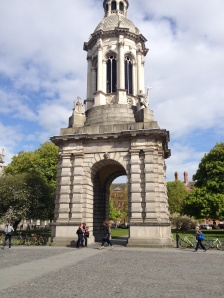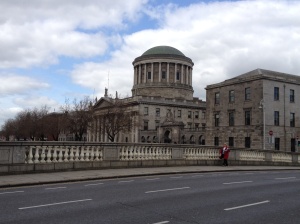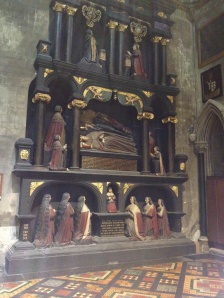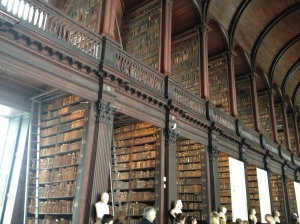Ah, the magic of walking through the city of Dublin on a sunny Monday morning! There’s even magic in the names of the destinations on the passing buses: Dunlaoghaire, Dalkey, Rathmines, Merrion Square …..
A brisk walk to Trinity College from my hotel takes about fifteen minutes, but it’s too early – the Library is not open for another hour, so I decide to use my day pass for the Hop On-Hop Off bus. This has got to be the best way to find your bearings in this city. A friendly bus driver near Trinity College gives me directions to the start of the bus route – it’s just across the river, a short walk. The city clocks are striking nine as I cross the Liffey on the O’Connell Bridge. The Liffey is a tidal river and I can hear the cry of seagulls as I walk down O’Connell Street and hop on the bus for a sightseeing tour of Dublin. Upstairs, front seat, left-hand side – best view!
Just as we’re about to leave, a horde of teenagers surges towards our departing bus, but it appears they are not getting on after all. ‘Thank God’, says our driver, Damian. ‘What a carry-on, where’s my rifle?’
So many immediate impressions! The elegant Georgian buildings with their wonderful porticoes and brightly painted front doors; the monuments, too many to mention; the cobblestones that still surface the old streets; the churches and cathedrals, the imposing public buildings, the many bridges spanning the wide river that bisects the city; the gift shops and Celtic craft shops. And the pubs – oh, the pubs are everywhere!
Dublin is built on a history that goes back more than a thousand years to the Vikings in the tenth century. Everywhere you look there are reminders of past times and events – some uncomfortably recent, like the small plaque set in the footpath on Nassau Street beside Trinity College, commemorating two people who were killed when a car bomb was detonated there in May 1974.
This is a part of the darker side of Dublin, like the homeless people on the streets – some sit on the footpath with blankets wrapped around their shoulders and call out to you as you pass by; the more active move along the bus queues that line Nassau Street and ask for loose change. I feel secretly relieved that I have no cash on me, but also ashamed to discover that, like almost everyone else, I soon learn the art of focusing on some point in the distance so as not to make eye contact with them. It reminds me too much of the Phil Collins song, ‘Another Day in Paradise’.
Back on the bus, the round trip is over and I return to Trinity College, which is now a seething mass of humanity. Not only is there a mile-long queue for the Book of Kells, there is also a graduation ceremony this morning. Note to self: come back early tomorrow and just stand there until they open Library doors. As long as it takes.
I’m keen to visit the Abbey Theatre, the National Theatre of Ireland, founded in 1904, where plays by Yeats, Synge, Shaw and O’Casey were first performed. The facade of the theatre looks surprisingly modern – sadly, the original building was destroyed in a fire in 1951. The theatre was forced to move to other premises, and it would be another fifteen years before a new theatre was built on this site. I’d love to take a peek inside but they’re busy putting up the set for ‘Twelfth Night’ which opens on the 25th of April, and the whole area is off limits to all but the cast and crew. I pick up a flyer and leave in search of a comfort stop.
Say what you like about McDonald’s, love it or loathe it, but it’s about the only place in this city where you can walk in off the street and use the toilet for free.
It’s hard to find a real Irish person in Dublin at this time of the year. To my provincial eyes the American and European invasion is astonishing and overwhelming, but I have been assured that it’s not a patch on what happens in the summer. And much to the dismay of many locals, these invaders have no concept of queuing!
Decide not to do the pub lunch after all – there’ll be precious little craic in this polyglot crowd – and instead catch another Hop On-Hop Off bus to Dublin Castle. Established by King John in 1204, very little of the original structure can be seen today – most of the building dates from the 18th century, and after my recent experiences in other castles I find this one a bit disappointing. The tea room, however, does quite a respectable latte and a nice bran muffin.
St Patrick’s Cathedral is a real eye-opener. In the manner of old cathedrals everywhere, it’s beautiful on the outside – but since when does one have to pay four euros to enter the house of God? Even the gift and souvenir shop is inside the church itself. I think it might be time for Jesus to make another appearance and start chucking things around again. There are some amazing monuments and tombs, of course, and you can see Jonathan Swift’s tomb where he is buried beside his beloved ‘Stella’.
There is another tomb at the rear of the Cathedral (just beside the gift shop), erected in 1632 by Richard Boyle, Earl of Cork (and father of Robert Boyle, the ‘father of chemistry’), in memory of his second wife, Lady Katherine. It’s quite beautiful, in a mind-bogglingly ostentatious kind of way.
The afternoon is getting on now and my poor little tootsies are just about falling off from all the walking I’ve done today, so it’s back on to the next Hop On-Hop Off that comes along. This will take me back to Trinity College – I’m going to have one last crack at the Book of Kells. My timing is spot-on, this time I’m right near the front of the queue.
The Book is situated in what they call the Treasury, a dimly lit cell within the Library. It’s set into a large table with a glass top and just enough light to see by. This is a fragile and precious item – we’re not even allowed to take photos (although there is always someone who tries to sneak one – today was no exception).
Finally, upstairs to the Long Library and the current ‘Brian Boru’ exhibit, including ‘Brian Boru’s Harp’. It wasn’t really his, of course, it only dates back to the 14th or 15th century and Brian Boru died at the Battle of Clontarf in 1014, but it is one of only three medieval Gaelic harps still in existence.
Also on display in the Long Library are some original manuscripts of Samuel Beckett.
Dublin has too much of everything, and one day doesn’t even skim the surface. I haven’t even mentioned the famous statue of Molly Malone with her barrow (locally referred to as the Tart with the Cart, or sometimes the Dolly with the Trolley); the childhood home of Oscar Wilde; the Four Courts; Christ Church; the Parnell monument; the grim Kilmainham Gaol where many leaders of Irish rebellions were imprisoned and executed; Dublinia (a museum focusing on the Viking and medieval history of the city); St Stephen’s Green, well known to readers of James Joyce; and Finn’s Hotel, where Joyce met Norah Barnacle on the 16th of June 1904 (giving rise to the novel ‘Ulysses’ and the saga of Leopold Bloom).
All things considered, I think I’ve done pretty well to get through all that I did today!
Tomorrow I’m off to Edinburgh to stay with my friend Ian, and looking forward to doing nothing very much.
- Comment
- Reblog
-
Subscribe
Subscribed
Already have a WordPress.com account? Log in now.












